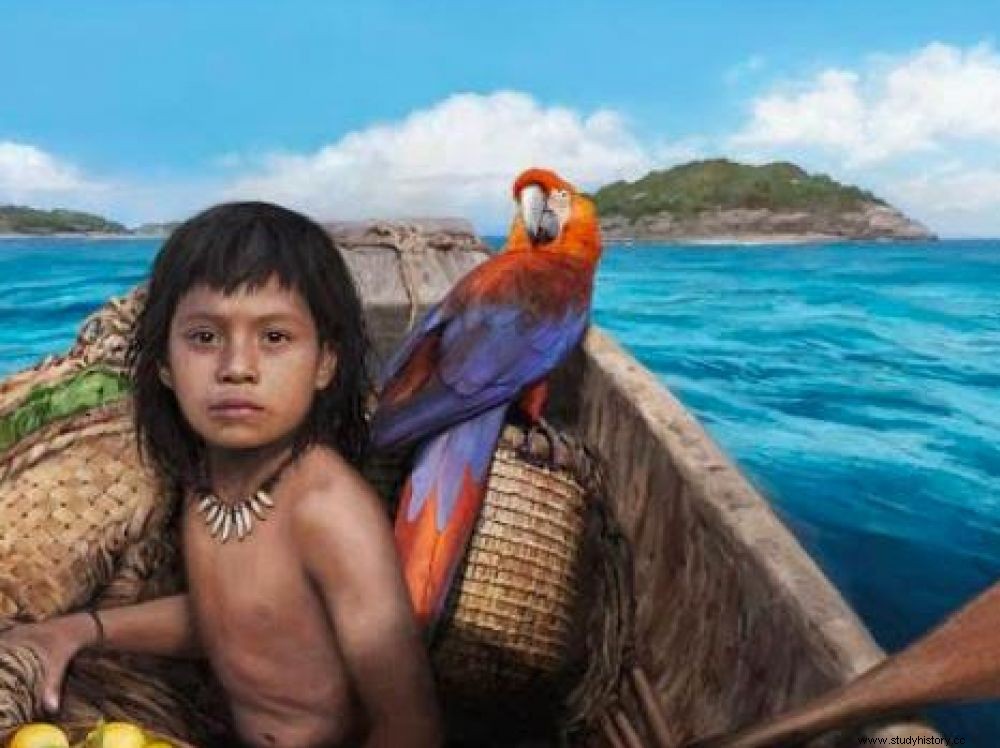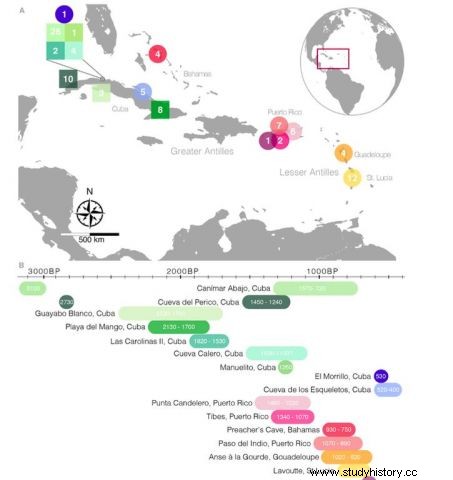New genetic studies report that several waves of ancient settlement existed between the Caribbean and the Americas, where these early island populations are believed to have originated.

Illustration of the exploration of the Caribbean by the first settlers.
Parrots, turquoise waters, and pristine beaches are the fantasized image generally conveyed by what is sometimes called the “New World Mediterranean”. But what do we really know about the Caribbean* and its ancient settlement? Of the origin of the first populations that reached the string of islands of the Caribbean arc?
"Genomic data obtained in a remarkable"
Genetic analyzes have just brought crucial details to a complex story. In an article published in the journal Science, a team of archaeologists and geneticists led by researchers from the University of Copenhagen (Denmark) and the Max Planck Institute for the Science of Human History, in Jena (Germany), have delivered unpublished information on the pre-Columbian occupation of these islands.
To do this, the scientists examined the genomes of 93 of these ancient islanders, established from samples of bones taken from 16 archaeological sites located in particular in Cuba, the Bahamas, Puerto Rico, Guadeloupe and Sainte- Lucia (see map ). "Genomic data obtained in a way remarkable, considering the unfavorable tropical climate of the Caribbean for the preservation of human remains" , explained Carles Lalueza-Fox, paleogeneticist at the Institute of Evolution (CSIC-UPF), in Barcelona (Spain), co-signatory of the article, joined by Sciences et Avenir.

Map of the Caribbean locating the location of the places sampled, with the number of individuals analyzed by site. The squares represent those linked to the "archaic" period, the circles, to the "ceramic" period. (B) Dates for each site are given in calibrated years BP (before present). ©Science
A settlement at several speeds
Parrots, turquoise waters, and pristine beaches are the fantasized image generally conveyed by what is sometimes called the “New World Mediterranean”. But what do we really know about the Caribbean* and its ancient settlement? Of the origin of the first populations that reached the string of islands of the Caribbean arc?
"Genomic data obtained in a remarkable"
Genetic analyzes have just brought crucial details to a complex story. In an article published in the journal Science, a team of archaeologists and geneticists led by researchers from the University of Copenhagen (Denmark) and the Max Planck Institute for the Science of Human History, in Jena (Germany), have delivered unpublished information on the pre-Columbian occupation of these islands.
To do this, the scientists examined the genomes of 93 of these ancient islanders, established from samples of bones taken from 16 archaeological sites located in particular in Cuba, the Bahamas, Puerto Rico, Guadeloupe and Sainte- Lucia (see map ). "Genomic data obtained in a way remarkable, considering the unfavorable tropical climate of the Caribbean for the preservation of human remains" , explained Carles Lalueza-Fox, paleogeneticist at the Institute of Evolution (CSIC-UPF), in Barcelona (Spain), co-signatory of the article, joined by Sciences et Avenir.

Map of the Caribbean locating the location of the places sampled, with the number of individuals analyzed by site. The squares represent those linked to the "archaic" period, the circles, to the "ceramic" period. (B) Dates for each site are given in calibrated years BP (before present). ©Science
A settlement at several speeds
According to these results, two first waves of settlement would have taken place at least 5,000 years ago, and probably a little earlier, from North America to the western Caribbean, and a third, 2,800 years ago, since this time the 'South America. These conclusions more or less coincide with the divisions that archaeologists had hitherto established concerning the pre-colonial history of the Caribbean with a so-called "archaic" period, for the first human settlements, and a second, called "ceramics", corresponding to the arrival 2,800 years ago of populations of horticulturists carrying ceramics. Groups originating from the continental regions of the Orinoco basin (Venezuela), whose expansion has been observed.
This work has also revealed the existence of genetic differences between the very first settlers from North America and the latest arrivals from South America. "Surprisingly, little mixing was observed between the two groups" , comments André Delpuech, director of the Musée de l’Homme, in Paris, specialist in the Amerindian history of the Caribbean, who did not participate in the publication. "Understanding this geographical space is complex because colonial history fragmented it into a mosaic of countries with different languages – English-speaking, French-speaking, Dutch-speaking, Spanish-speaking – which was not the case in the pre-Columbian times, when men moved freely through all these islands. As this study does, we must think in terms of archipelagos within a sea that connects men" , added André Delpuech, who responded to Sciences et Avenir.
The Caribbean islands seem to have been colonized for the first settlements from the Lesser Antilles, then over the millennia, from these points of entry, the populations of fisher-gatherers dispersed, occupying according to the explorations of the maritime space , the totality of all the islands. "Something quite close to what happened in Europe, when Mesolithic hunter-gatherers were colonized by Neolithic farmers" , added paleogeneticist Carles Lalueza-Fox. The descendants of the third wave ceramic populations, - Tainos and Kalinago (formerly called Karib) - are ultimately the societies that Christopher Columbus encountered on his arrival when he reached the Bahamas Islands in 1492 on his first voyage.
*For some geographers, the Caribbean is not only the Caribbean islands strictly speaking (Greater Antilles, Lesser Antilles, Bahamas), but all the lands washed by the Caribbean Sea, i.e. the frontage of the American continent which extends from Central America to the Guiana Shield, passing through the coastal plains of Colombia and Venezuela.
